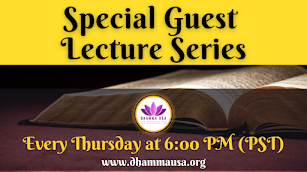Dasa Saṃyojana - Ten Fetters - Part 1
Sotāpannassāti sotāpattiphalaṃ pattassa.
sutta>khuddaka>Mahāniddesa>《Mahāniddesa-aṭṭhakathā》>Mahāniddesa-aṭṭhakathā>2. Guhaṭṭhakasuttaniddesavaṇṇanā>para. 386
Sotāpanna
Sotāpanna: the 'Stream-winner' or 'stream-entrant', is the lowest of the 8 Noble Disciples see: ariya-puggala Three kinds are to be distinguished: the one 'with 7 rebirths at the utmost' sattakkhattu-parama, the one 'passing from one noble family to another' kolankola the one 'germinating only once more' eka-bījī
As it is said e.g. Pug. 37-39; A. III, 87:
- If a man, after the disappearance of the 3 mental chains personality-belief, skeptical doubt, attachment to rules and ritual; see: samyojana has entered the stream to Nibbāna, he is no more subject to rebirth in lower worlds, is firmly established, destined to full enlightenment. After having passed amongst the divine and human beings only seven times more through the round of rebirths, he puts an end to suffering. Such a man is called 'one with 7 births at the utmost' sattakkhattu-parama.
- If a man, after the disappearance of the 3 mental chains. is destined to full enlightenment, he, after having passed among noble families two or three times through the round of rebirths, puts an end to suffering. Such a man is called 'one passing from one noble family to another' kolaṅkola.
- If a man, after the disappearance of the 3 mental chains. is destined to full enlightenment, he, after having only once more returned to human existence, puts an end to suffering. Such a man is called 'one germinating only once more' eka-bījī See Sotāpatti-Saṃyutta S. LV.
Characteristics of a Sotapanna
- The sotapanna has abandoned the first three of the lower fetters: personality view, doubt, misapprehension of precepts and vows. (Ratanasutta Sn. 233)
- He is freed from the possibility of rebirth in the four lower realms. (Ratanasutta Sn. 234)
- He is incapable of concealing any bodily, verbal or mental transgression. (Ratanasutta Sn. 235)
- He has abandoned any lust, hate or delusion that would be strong enough to cause rebirth in the lower realms. (Abhabba Sutta AN. iii. 438)
(Bahudhātuka Sutta MN. 115)
- treating any saṅkhāra as permanent,
- treating any saṅkhāra as pleasurable,
- treating any dhamma as self,
- killing his mother,
- father or an arahant,
- causing bleeding in a Tathagata with evil intent,
- splitting the Sangha, or
- going over to another teacher.
He is incapable of living without reverence for the Buddha,
- the Dhamma,
- the Sangha, and
- the training.
- Nor can he embrace any of the 62 wrong views or take an eighth birth.
- He is incapable of seeking outside the Sangha for persons worthy of gifts.
He cannot fall into the six wrong views that
- pleasure and pain are self-wrought, or
- wrought by another, or
- wrought by both oneself and another, or
- arise by chance without any act by self, or
- arise by chance without any act by another, or
- arise by chance without any act by either self or another. "For the one attained to right view sees well both causes and dhammas that are causally arisen."
- He is fixed unshakably in the True Dhamma,
- is incapable of backsliding (to being a worlding),
- his future dukkha is finite,
- he has attained to knowledge not common to worldlings,
- cause and causally arisen dhammas are seen rightly by him.
The Ogadha Sutta (S 55.2); SD 3.3(4.1.4):
The qualities of a streamwinner: The Ogadha Sutta (S 55.2) simply defines the “qualities of a stream-winner” (*sotāpanna,dhamma) as follows:
- wise faith in the Buddha, buddhe aveccappasāda
- wise faith in the Dharma, dhamme aveccappasādena
- wise faith in the Sangha, and saṅghe aveccappasādena
- moral virtue dear to the noble ones. ariya,kanta sīla
Here, the term “qualities of a stream-winner” is a general one, which is probably an old term, which is later replaced by the phrasal term, “the limbs of stream-winning” (sotāpannassa aṅga) in contrast to “the limbs for stream-winning” (sotāpatti-y-aṅga). However, as we will see below, their usages significantly overlap.
Qualities to be cultivated: (Sotāpatti-y-) Aṅga Sutta (S 55.50):
Where the person involved is clearly a non-stream-winner, the qualities he should cultivate for his spiritual development are usually called “the limbs for stream-winning” (sotāpatti-y-aṅga). According to the (Sotāpatti-y-) Aṅga Sutta (S 55.50), these 4 limbs for stream-winning, “when cultivated, often developed, lead to the realization of the fruit of stream-winning,” comprise the following:
(1) Associating with true individuals. sappurisa,saṁseva
(2) Hearing the true teaching. saddhamma,savana
(3) Wise attention. yoniso,manasikāra
(4) Practice of the Dharma in accordance dhammânudhamma,paṭipatti with the Dharma.
(S 55.50/5:404), SD 70.1(1)
In other words, these are 4 conditions that conduce to the attaining of stream-winning in someone who is not yet a stream-winner.
Sakkāyadiṭṭhi
PTS: M i 299 - MN44 - Culavedalla Sutta: The Shorter Set of Questions-and-Answers
“Kathaṃ panāyye, sakkāyadiṭṭhi hotī”ti? “Idhāvuso visākha, assutavā puthujjano, ariyānaṃ adassāvī ariyadhammassa akovido ariyadhamme avinīto, sappurisānaṃ adassāvī sappurisadhammassa akovido sappurisadhamme avinīto, rūpaṃ attato samanupassati, rūpavantaṃ vā attānaṃ, attani vā rūpaṃ, rūpasmiṃ vā attānaṃ. Vedanaṃ…pe… saññaṃ… saṅkhāre… viññāṇaṃ attato samanupassati, viññāṇavantaṃ vā attānaṃ, attani vā viññāṇaṃ, viññāṇasmiṃ vā attānaṃ. Evaṃ kho ¶, āvuso visākha, sakkāyadiṭṭhi hotī”ti.
“Kathaṃ panāyye, sakkāyadiṭṭhi na hotī”ti?
"But, lady, how does self-identification come about?"
"There is the case, friend Visakha, where an uninstructed, run-of-the-mill person — who has no regard for noble ones, is not well-versed or disciplined in their Dhamma; who has no regard for men of integrity, is not well-versed or disciplined in their Dhamma — assumes form (the body) to be the self, or the self as possessing form, or form as in the self, or the self as in form.
"He assumes feeling to be the self...
"He assumes perception to be the self...
"He assumes (mental) fabrications to be the self...
"He assumes consciousness to be the self, or the self as possessing consciousness, or consciousness as in the self, or the self as in consciousness. This is how self-identification comes about."
“Idhāvuso visākha, sutavā ariyasāvako, ariyānaṃ dassāvī ariyadhammassa kovido ariyadhamme suvinīto, sappurisānaṃ dassāvī sappurisadhammassa kovido sappurisadhamme suvinīto, na rūpaṃ attato samanupassati, na rūpavantaṃ vā attānaṃ, na attani vā rūpaṃ, na rūpasmiṃ vā attānaṃ. Na vedanaṃ…pe… na saññaṃ… na saṅkhāre…pe… na viññāṇaṃ attato samanupassati, na viññāṇavantaṃ vā attānaṃ ¶, na attani vā viññāṇaṃ, na viññāṇasmiṃ vā attānaṃ. Evaṃ kho, āvuso visākha, sakkāyadiṭṭhi na hotī”ti.
"But, lady, how does self-identification not come about?"
"There is the case where a well-instructed disciple of the noble ones — who has regard for noble ones, is well-versed & disciplined in their Dhamma; who has regard for men of integrity, is well-versed & disciplined in their Dhamma — does not assume form to be the self, or the self as possessing form, or form as in the self, or the self as in form.
"He does not assume feeling to be the self...
"He does not assume perception to be the self...
"He does not assume fabrications to be the self...
"He does not assume consciousness to be the self, or the self as possessing consciousness, or consciousness as in the self, or the self as in consciousness. This is how self-identification does not come about."
Vicikicchā:
Kaṅkhī hotīti buddha, dhamma, saṅghaguṇesu ceva sikkhāya ca pubbante ca aparante ca pubbantāparante ca paṭiccasamuppāde cāti aṭṭhasu ṭhānesu kaṅkhāya samannāgato hoti.
1. Doubt in the virtues of the Buddha
2. Doubt in the virtues of the Dhamma
3. Doubt in the virtues of the Sangha
4. Doubt in the morality
5. Doubt in the previous birth
6. Doubt in the future birth
7. Doubt in both the previous and future births
8. Doubt in the Dependent Origination
Vigatā cikicchāti vicikicchā, sabhāvaṃ vā vicinanto etāya kicchati kilamatīti vicikicchā, sā saṃsayalakkhaṇā, saṃsappanarasā, anicchayapaccupaṭṭhānā, anekaṃsaggāhapaccupaṭṭhānā vā, ayonisomanasikārapadaṭṭhānā. Paṭipattiantarāyakarāti daṭṭhabbā.
sutta>khuddaka>Mahāniddesa>《Mahāniddesa-aṭṭhakathā》>Mahāniddesa-aṭṭhakathā>1. Kāmasuttaniddesavaṇṇanā>para. 221
Sīlabbataparāmāsa
Interesting Discussion on the subject in Sutta Central:
MN 24 (Ratha-vinita Sutta: Relay Chariots)
we know that purification of morality is not Nibbana itself and therefore should not be clung to.
Furthermore, AN 3.78
Kukkuravatika Sutta (MN-57) is often cited to explain the 3rd fetter. The ox-duty ascetic and the dog-duty-ascetic vows and practices are used as examples. But how many people, not to mention reasonable Buddhists, would vow and practice such extreme behaviors?
How did Sarakani become a stream enterer despite having an alcohol drinking habit?
Pañcakkhandha – Piya Tan:
- Form (rūpa) arises when we give it a name (nāma). A thing “exists” for us when we put our minds to it.62 In this sense, our world is mind-made.
- Feeling (vedanā) arises when any of our sense-faculties attends to an external object by way of the triangle of experience.
- Perception (saññā) arises with feeling, when we recognize the hedonistic tone of an object or react with liking towards a pleasurable object, or with dislike towards an unpleasant object, or with neutral feeling towards a neutral object.
- Formations (saṅkhārā) arise when we colour our perceptions with greed, grasping at a desirable object, or with hate, rejecting an undesirable object, or ignoring a neutral object.
- Consciousness (viññāṇa) is the stage for all these drama, it is “a tale told by an idiot, full of sound and fury, signifying nothing.”
More Readings:
- https://tipitaka.app/
- https://www.wikipali.org/app/search/paliword.php?key=sakk%C4%81yadi%E1%B9%AD%E1%B9%ADhi
- https://www.wikipali.org/app/search/paliword.php?key=vicikicch%C4%81
- https://www.wikipali.org/app/search/paliword.php?key=s%C4%ABlabbatapar%C4%81m%C4%81so
- https://www.wikipali.org/app/search/paliword.php?key=s%C4%ABlabbatapar%C4%81m%C4%81so
- https://www.wikipali.org/app/search/paliword.php?key=vivicceva
- https://discourse.suttacentral.net/t/the-third-lower-fetter-silabbata-paramasa/8952
- https://www.accesstoinsight.org/tipitaka/mn/mn.057.nymo.html
- https://www.accesstoinsight.org/tipitaka/mn/mn.024.than.html
- https://suttacentral.net/search?query=sakkayaditthi
- https://www.themindingcentre.org/dharmafarer/wp-content/uploads/2019/02/47.1-Sotapanna-Nandiya-S-s55.40-piya.pdf
- https://www.accesstoinsight.org/tipitaka/sn/sn55/sn55.040.than.html
- https://www.accesstoinsight.org/tipitaka/mn/mn.044.than.html
- https://www.themindingcentre.org/dharmafarer/wp-content/uploads/2009/12/29.1a-Bahudhatuka-S-m115-piya1.pdf
- https://www.dhammawiki.com/index.php/Sotapanna
- https://www.accesstoinsight.org/tipitaka/an/an06/an06.097.than.html
































0 comments:
Post a Comment
Your comments and feedback are very helpful to us in improving our posts. We really appreciate your time. Thank you!
Dhamma USA Team.